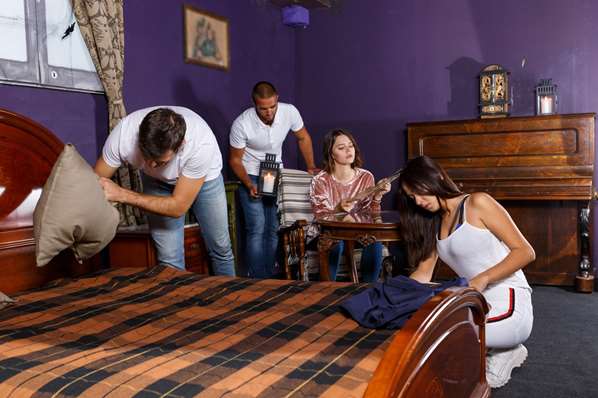
Escape rooms test problem-solving skills, teamwork, and the ability to think under pressure. Whether you’re a first-timer or a seasoned player, having the right strategies makes all the difference. Instead of guessing your way through, a well-planned approach can save time and keep the game moving.
An escape game is designed to be immersive, offering a mix of logic puzzles, hidden clues, and physical challenges. Each room follows a specific theme, whether it’s a spy mission, a haunted house, or an archaeological adventure. The goal is simple: solve a series of puzzles to progress and ultimately escape before time runs out.
The difficulty varies from room to room, with some requiring intense collaboration and critical thinking. Walking into an escape room without a plan can lead to wasted time and frustration, but with the right approach, you’ll maximize your chances of success.
1. Communication Is Everything
Success in escape rooms depends on teamwork and the ability to solve puzzles efficiently. Talk through your thoughts, share discoveries, and listen actively. Often, someone else holds a piece of the puzzle that fits with yours, but you won’t know unless you speak up. If something looks important, mention it. Even if a clue doesn’t seem relevant immediately, another teammate may have insight into how it connects.
Clear and effective communication prevents chaos. A common mistake among teams is working in silence or assuming others know what they’re thinking. If you find a key, state it aloud. If a code isn’t working, let your teammates know instead of repeatedly trying the same combination.
Assigning roles can also help. For instance, having one person focus on gathering clues while another takes charge of decoding ensures efficiency. The more structured your approach to communication, the smoother the experience.
2. Divide and Conquer—Then Regroup
Instead of crowding around a single lock or puzzle, split up to cover more ground. Assign tasks among team members based on different skill sets—some players might excel at logic puzzles, while others are better at spotting hidden objects. However, checking in with each other is just as important. If one area isn’t yielding results, switch focus. A fresh set of eyes often catches something previously overlooked.
A well-balanced team knows when to divide and when to regroup. If two people are working on a puzzle without progress, rotating teammates can provide new insights. Some puzzles require multiple hands or simultaneous actions, so staying aware of what others are doing allows for better coordination. For example, some escape rooms, like Hour To Midnight in Portland, are known for intricate multi-step puzzles that demand different skill sets, making division of labor a key factor in success.
3. Stay Organized and Track Progress
A cluttered space leads to missed clues. Designate a spot for used keys and solved puzzles so they don’t get revisited unnecessarily. Keep an inventory of what’s been found and what’s still needed. Many rooms allow objects to be used only once, so knowing which items are still in play prevents wasted time.
One common oversight is misplacing important objects. If an item is used, set it aside where it won’t be confused with unused clues. Some teams make the mistake of leaving clues scattered, leading to repeated efforts in solving puzzles that have already been completed. Keeping track of locks that still need combinations and unopened containers helps narrow down the next steps. Whiteboards or notepads, when available, can be useful tools for tracking patterns and codes.
4. Think Like a Game Designer
Escape rooms in education and entertainment are carefully crafted to guide players toward solutions. If a puzzle feels unsolvable, reconsider your approach. Game designers often use patterns—matching colors, numerical sequences, or common puzzle mechanics. If a combination lock has four digits, search for numbers presented in a grouping of four. If a clue seems too obvious, it might be leading you to something deeper.
Understanding how designers think can give you an advantage. For instance, puzzles are often layered, meaning one clue leads to another before revealing the final solution. Some rooms incorporate red herrings to mislead players, so focusing on elements that seem deliberately placed rather than random decorations can help. Additionally, familiarity with common puzzle types, such as ciphers, pattern recognition, and logic grids, can speed up problem-solving.
5. Manage Your Time Wisely
Time is the biggest challenge in any escape room. Avoid getting stuck for too long on one puzzle. If a solution isn’t clicking, move on and revisit it later. Many teams waste precious time by focusing on a single challenge instead of exploring other available clues. Most escape rooms allow hints—using one strategically can prevent getting stuck and keep momentum going.
Set informal time limits on solving puzzles. If a team spends more than five minutes without progress, shift gears. Some rooms display timers, while others require players to keep track of themselves. Staying mindful of time helps with decision-making, ensuring that momentum is maintained. Hints aren’t a sign of failure—knowing when to ask for assistance is part of a winning strategy.
6. Expect the Unexpected
Escape rooms thrive on misdirection. False leads, distractions, and hidden compartments keep players engaged. If something seems out of place, it probably serves a purpose. Keep an open mind and test different possibilities—items might interact in ways that aren’t immediately obvious.
Hidden doors, concealed compartments, and props hiding in plain sight might hold the key to advancing. Testing unusual interactions—turning objects, aligning patterns, or moving items—can yield surprising results. Teams that remain flexible and open to trying different approaches tend to perform better.
7. Work With, Not Against, the Game Master
The game master monitors progress and can offer hints when necessary. Their role isn’t to make the game impossible—it’s to create an engaging experience. If a team is truly stuck, a well-timed hint can push things forward without diminishing the challenge. Pay attention to any nudges they provide, as they often signal overlooked details.
8. Keep an Eye on Details
The smallest elements can hold the biggest answers. A slight color variation, a number sequence on a book spine, or a pattern on the floor could be part of a hidden code. Overanalyzing can slow a team down, but brushing past small details can cause missed opportunities. If something feels intentional, test whether it has a function.
9. Avoid Overcomplicating Solutions
Escape rooms reward logical thinking. While creativity helps, adding unnecessary layers to a problem wastes time. If a puzzle involves a basic cipher, it likely doesn’t require advanced decryption techniques. The answer is often simpler than it appears—trust the game design and avoid making assumptions beyond what the room presents.

10. Have Fun and Stay Calm
While beating the clock is exciting, the real goal is the experience. Stressing over every minute won’t help. Teams that stay relaxed and enjoy the process tend to perform better. If one attempt doesn’t lead to an escape, learning from the mistakes improves future performance. The more escape rooms you try, the sharper your problem-solving skills become.
Final Thoughts
Escape rooms challenge how you think, communicate, and solve problems under pressure. The most successful teams approach the game with a clear plan, remain flexible, and use every available resource. Instead of relying on a single strategy, adapting to the room’s design and working efficiently makes the difference. The more you play, the better you get, making every attempt a step toward mastering the challenge.
About the Author
Laura Green is a writer and puzzle enthusiast with a passion for strategy and problem-solving. She enjoys exploring the psychology behind teamwork and critical thinking, translating her insights into engaging content. When she’s not writing, you can find her perfecting her skills in competitive trivia or experimenting with new board game strategies.




